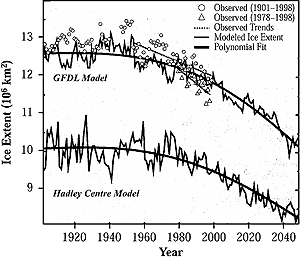|
Continued from previous page
|

Figure 16-6: Observed and modeled variation of annual averages
of Arctic sea-ice extent, based on Vinnikov et al. (1999). Observed
data are from Chapman and Walsh (1993) and Parkinson et al. (1999).
Sea-ice curves are produced by GFDL low-resolution R15 climate model and
by HADCM2 climate model, both forced by CO2 and aerosols.
|
An increase in temperature is likely to lead to shifts
in species assemblages. Organisms that are unable to tolerate the present low-temperature
regime will invade the Southern Ocean. Some that already are there will exhibit
increased rates of growth. Predicted reductions in the extent and thickness
of sea ice will have ramifications not only for the organisms directly associated
with sea ice but also for those that rely on oceanographic processes that are
driven by sea-ice production. In the open ocean, there is a correlation between
the standing crop and productivity of phytoplankton with wind speed (Dickson
et al., 1999). Diatoms—the dominant phytoplanktonic organisms in
the Southern Ocean—have high sinking rates and require a turbulent mixed
zone to remain in the photic zone. If climate change results in diminution of
wind forcing of surface mixing, a reduced biomass of diatoms can be expected.
This would lead to less available food for the higher trophic levels and diminution
in the vertical flux of carbon and silicon. Together, these effects are likely
to have a profound impact on Antarctic organisms at all trophic levels, from
algae to the great whales.
Any reduction in sea ice clearly represents a change in habitat for organisms
that are dependent on sea ice, such as Crabeater seals and Emperor penguins.
Some species of penguins and seals are dependent on krill production. Increased
ultraviolet irradiance from ozone depletion is likely to favor the growth of
organisms with UV-protecting pigments and/or repair mechanisms (Marchant, 1997;
Davidson, 1998). This will lead to a change in species composition and impact
trophodynamics and vertical carbon flux. Naganobu et al. (2000) show
evidence that ozone depletion impacts directly and indirectly on krill density.
The growth, survival, and hatching rates of penguin chicks and seal pups are
directly influenced by krill abundance in the sea. Animals that migrate great
distances, such as the great whales and seabirds, are subject to possible disruptions
in the timing and distribution of their food sources. Contraction of sea ice
may alter migration patterns but would not be expected to present a major problem
to such mobile animals. Other marine mammals (seals, sea lions) have life histories
that tie them to specific geographic features such as pupping beaches, ice fields,
or sub-Antarctic islands; they may be more severely affected by changes in the
availability of necessary habitats and prey species that result from climate
change.
|